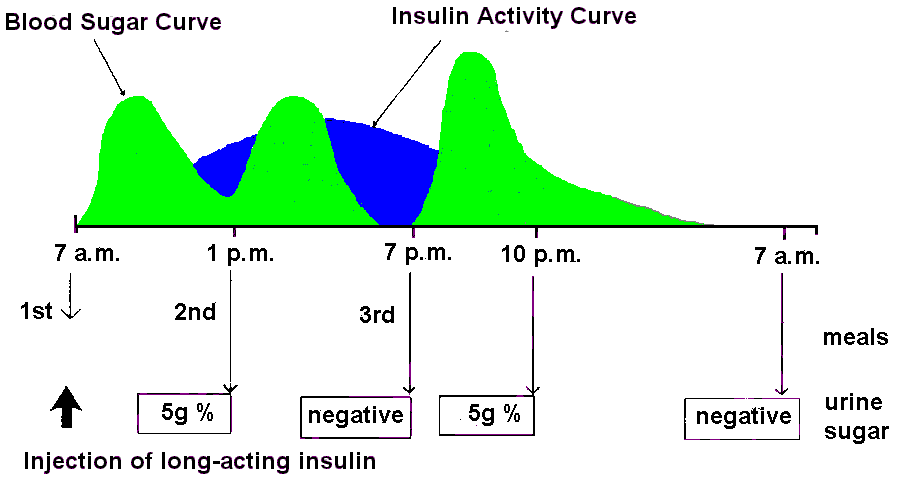We have learnt that there are two main types of insulin:
Regular insulin & Long-acting insulin
|
Because of the differences in their duration of action, someone with diabetes can be treated either with 3 daily injections of regular insulin or 1 or 2 daily injections of long-acting insulin.
|
To give 3 daily injections of regular insulin is admittedly troublesome, but it is
more physiological.
To give one daily injection of long-acting insulin is certainly less painful, but it has
disadvantages. We shall try to explain these by using an example.
The term: physiological processes means the normal healthy
functioning of the organs of the body (heart, liver, kidney, pancreas, etc.).
|
1. After giving an injection of long-acting insulin at 7 a.m. someone with diabetes has breakfast. As the long-acting insulin takes a long time to produce its effect, breakfast is followed by a steep rise in blood sugar.
2. Towards the end of the morning the long-acting insulin is working very strongly. There is some risk of a hypoglycaemic episode as the blood sugar is so low. Nevertheless, the urine still contains a lot of glucose, because of the marked rise in blood sugar earlier in the morning.
3. After lunch the blood sugar level rises steeply once more, but during the late afternoon it falls again to dangerously low levels, since the long-acting insulin is still producing its effect.
4. This means that the urine sample tested before the evening meal shows no sugar.
5. After the evening meal the blood sugar rises steeply again, as the effect of the
long-acting insulin is wearing off. A urine sample tested before going to bed therefore contains a lot of sugar.
6. Because the patient has nothing to eat during the night, the blood sugar falls again. The fasting urine sample collected next morning therefore contains no sugar.
From this example it is clear that a single injection of long-acting insulin is highly unsatisfactory for controlling the rises in blood sugar after meals, and yet can produce very low blood sugar levels before meals and during the night.
|
How can we do better? There are two ways:
1.
Before each of the three main meals we can give
regular insulin as a booster rate injection
together with a small amount of
long-acting insulin as a basal rate injection.
This mode of insulin treatment is termed
intensive conventional insulin therapy.
However, for a person taking three main meals, this means four insulin injections a day.
Click here to
simulate an example case using this mode of treatment
2.
We can give two injections of long-acting insulin and by taking at least
6 or 7 meals a day we can adjust food intake to fit in with the effects of the long-acting insulin, with the aim of lessening the fluctuations in blood sugar.
This mode of insulin treatment is termed
conventional insulin therapy.
This reduces the number of injections to two a day, but means that 6 or 7 meals have to be taken.
Click here to
simulate an example case using this mode of treatment
|




